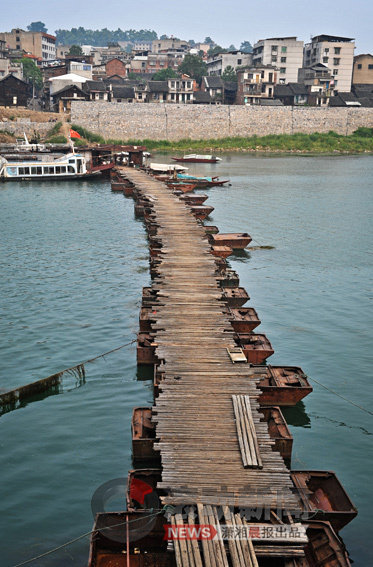From Sina:
Xiangjiang in Photos: 817 Kilometers of Beauty and Pollution
Our Xiangjiang River
It might take a hundred million years for the land to create a river;
it takes ten thousand years for a river to nurture a group of creatures;
it takes a thousand years for these creatures to build a city beside the river;
but, it might only take a hundred years for a river to be destroyed.
On September 10th, at Butang Ferry of Qiyang River, a large number of sand digging vessels stirred the deposits in the river, like yellow foams of vomit floating on the surface of water, forcing the river to be contaminated again. The polluted Xiangjiang River in the photographers’ shots affected every single nerve of us volunteers. Those of us who originally thought we’d see beautiful scenery instead were weighed down with a heavy heart all along the way. Is this our Xiangjiang River? Photographed by Li Feng of Xiaoxiang Morning Paper [click images to enlarge]
From September 4th to September 21st, the First Environmentally Conscious Activity of Floating throughout Xiangjiang River Valley was carried out. Volunteers took 18 days taking more than a thousand photographs recording the beautiful view and environmental issues of the Xiangjiang River. Picture made by Shuai Lingxi of Xiaoxiang Morning Paper
On September 5th, in the fog, the floating in the Ling River of Xingan County, Guangdong Province, started. There are around 20 million people living alongside the Xiangjiang River Valley; they drink water directly from the waters of Xiangjiang River. However, due to a lack of long-term and effective supervision on the emission of industrial waste along the Valley, Xiangjiang River has become one of the rivers in China that are most severely polluted by heavy metals. Photographed by Li Feng of Xiaoxiang Morning Paper
On September 8th, Shiyantou Village of Shiqihe River, Yongzhou, there were large amounts of garbage. The Villagers don’t have a waste treatment plant, so the villagers discarding these non-degradable garbage is a problem. Photographed by Li Feng of Xiaoxiang Morning Paper
September 7th, Lashan County’s Yegouling range is one of the sources of the Xiangjiang River, and the only one thankfully with water. Water flows down from the highlands, with the water having a beautiful milky white color when a slow shutter speed is used to take the shot. Photographed by Li Feng of Xiaoxiang Morning Paper
Xiangjiang River’s first-level tributary, Chongling Water, flows through Songbo Town and to Jiangyou Lake fraught with chromic slags. Red water like blood is left in this man-made lake, slowly infiltrating to the entrance of Xiangjiang River. Photographed by Li Feng of Xiaoxiang Morning Paper
Shigu Academy has accompanied Xiangjiaing River and Zhengshui Rivier for over a thousand years. Seeing the fascinating scenery from a boat, we temporarily forget the lands contaminated by heavy metals. Photographed by Xu Huiming of Xiaoxiang Morning Paper
At the drainage gate of Jianning harbor, Zhuzhou, sewage is directly discharged into the waters of Xiangjiang River. A skyscraper in the city is reflected on the surface of water with distinctive colors of black and white. Photographed by Li Feng of Xiaoxiang Morning Paper
A pontoon bridge on the waters of Xiaoshui River (the largest tributary of Xiangjiang River) in Liuzimiao, Lingling District, Yongzhou City. Photographed by Li Feng of Xiaoxiang Morning Paper
In the waters of Xiangjigng River in Santan Village, Hengdong County where water samples are taken, all kinds of domestic refuse and pharmaceutical bottles are carelessly disposed of. Eutrophication, sand-digging vessels and fishing with electricity have made the water an unbearable sight. Photographed by Li Feng of Xiaoxiang Morning Paper
In Xiangjiang River through Yongzhou City, sand-digging vessels abound in the water, making deep and shallow pits here and there. Simply passing through the waters safely was like playing the MapleStory game for the team members. Photographed by Li Feng of Xiaoxiang Morning Paper
In Zhushan, Yongzhou City, the manganese ore has harmed the mountains; the fields have begun to crack. The dazzling red is in sharp comparison with the green plants around. Photographed by Li Feng of Xiaoxiang Morning Paper
September 14th, the entrance where Zhenshui River flows into Xiangjiang River, Eichhornia crassipes grow profusely due to eutrophication. Small restaurants on fishing boats around nourish the growth of such water plants. Photographed by Li Feng of Xiaoxiang Morning Paper
On September 11th, chromic slags were found in Songbo Town, Changning City, carelessly dumped by the side of the river no more than 1000 meters from the mouth of the Xiangjiang River. Photographed by Li Feng of Xiaoxiang Morning Paper
On September 15th, at the drainage gate of Xiawan smeltery in Qingshuitang, Zhuzhou City, water stinks and runs noisily like a cascade. Photographed by Li Feng of Xiaoxiang Morning Paper
On September 16th, at the drainage gate of Yisu River, Tieniubu, Xiangtan County, soil and sand on the beach of Xiangjiang River have become black and disgusting with a putrid smell. Photographed by Li Feng of Xiaoxiang Morning Paper
In the evening of September 11th, volunteers secretly visited the smelter enterprise located in Songbo Town, Changning City beside the Xiangjiang Rivier. The chimney is brazenly puffing dense smoke into the air. The heavily wounded Xiangjiang River is wearing away. Photographed by Li Feng of Xiaoxiang Morning Paper
Comments from Sina:
新浪网友想念老蒋:
Those enterprises brazenly discharging wastes should be heavily fined until they go bankrupt, never to recover. Those officials in relevant governmental departments who are responsible for supervision and oversight should be dismissed from their positions and put in jail, never to be given a post ever again.
新浪网友学习:
I grew up in Shanghai. At 20, I came to Hunan province. That was 1973 and at that time, the water of the Xiangjiang River was clear and clean, with golden sand on the shores, with little shrimp and fish visible in the water. We stepped on the soft sand and swam in the water, while wooden boats paddled slowly in the middle of the river. I had never met such a beautiful place. Our Shanghai’s Huangpu River was muddy, stunk, and the drinking water from it was difficult to swallow. The streets of Changsha [the capital of Hunan Province] were of particular ethnic characteristics with sidewalks made of small pebbles, wells and green trees everywhere. Houses were also special. In the city, one could see 2-story wooden houses with unique style. But now buildings are neither Western nor Eastern and are poorly organized. In the Wast you see a building with European style, while in the west you see a outdated building with Chinese style. All of those building are messily put together with no order. It has ruined such a great city.
新浪网友亮亮:
The failure of the local government.
新浪网友yang:
Great photographs, but according to Chinese convention, they must be seen by a government official with a relatively higher rank. Then the official can do something.
新浪网友zhuyu970206:
It is the management of the environment that should be used to evaluate a government official’s work.
新浪网友136*****[email protected]:
Maybe within 10 years, there won’t even be any more drinkable water.
新浪网友一切随风:
Hurry and save the river of my hometown! It’s not just pollution, but also deforestation of the upper reaches of its tributaries and now practically there’s no more water flowing!
新浪网友wuming1488:
This is what our current situation is. For the interests of the minority, it’s not enough that everyone suffers, they also have to exercise arbitrary and arrogant rule over us poor folk!
新浪网友闲云野鹤之2008:
This kind of economic development is worse than not developing. This is a model of suicide! Polluting is easy, but managing [pollution] is difficult. We can no longer use the model of economic development first and then management/conservation afterward! The only thing that can destroy humanity on the earth is humanity itself!!!



















58 Comments
Leave a Reply